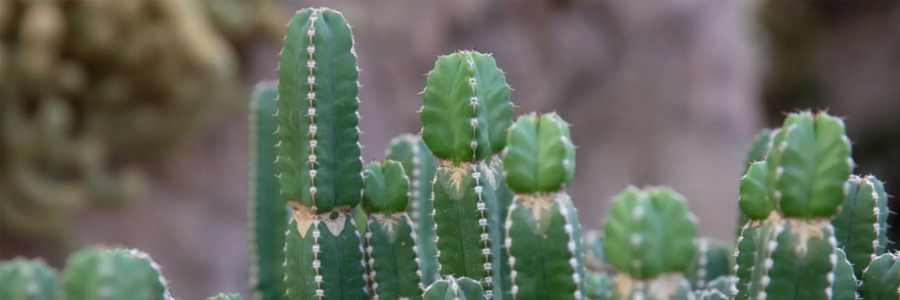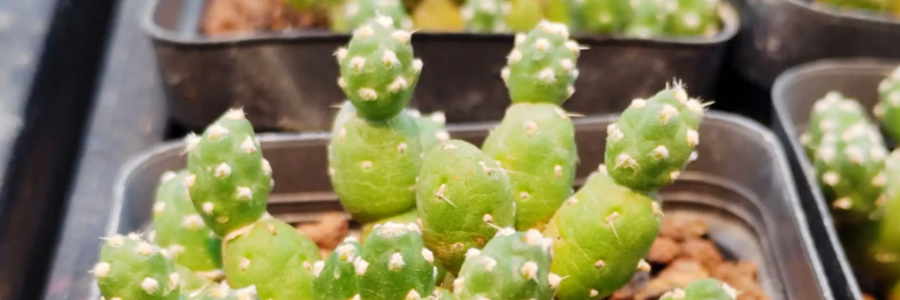Euphorbiaceae
Taxonomic Classification
The Euphorbiaceae family is a large and diverse group within the plant kingdom. It encompasses numerous genera and species, with estimates ranging from around 7,500 to over 8,000 species. The family name “Euphorbiaceae” is derived from the Greek physician Euphorbus, who was said to have used plants from this family for medicinal purposes. Euphorbiaceae plants are widespread across the globe, with a significant presence in tropical and subtropical regions, but also found in temperate zones. Many species within this family are succulent, and they have evolved unique characteristics to adapt to various environments.

Morphological Characteristics
1.Stem and Leaf Adaptations
One of the most notable features of Euphorbiaceae succulents is their diverse stem forms. Some species, like Euphorbia tirucalli (Pencil Cactus), have thin, pencil – shaped stems that can grow upright or in a somewhat sprawling manner. These stems are often green and photosynthetic, allowing the plant to carry out photosynthesis even in the absence of typical leaves. In contrast, Euphorbia obesa (Baseball Plant) has a spherical, almost perfectly round stem. The stems of Euphorbiaceae succulents are usually succulent, storing water to survive in arid conditions.
The leaves of Euphorbiaceae succulents also vary greatly. Some species have reduced or absent leaves, as the stems take over the photosynthetic function. For example, in Euphorbia trigona (African Milk Tree), the leaves are small and short – lived, while the ridged, three – angled stems are the main organs for water storage and photosynthesis. Other species may have more developed leaves, such as Euphorbia lactea (White – ribbed Euphorbia), which has lance – shaped leaves that grow in a spiral pattern along the stem when the plant is young, but may shed them as it matures.
2.Spines and Glochids
Many Euphorbiaceae succulents possess spines or glochids. The spines are modified leaves or stipules and serve multiple purposes, including protection against herbivores and reducing water loss by creating a boundary layer of still air around the plant. In Euphorbia milii (Crown of Thorns), the stems are covered in sharp, stout spines. Glochids, which are tiny, barbed bristles, are also present in some species. These can be easily detached and cause irritation if they come into contact with skin.
3.Milky Sap
A characteristic feature of Euphorbiaceae plants is the presence of a milky, latex – like sap. When the plant is injured, this sap is exuded. The sap contains various chemicals, some of which can be toxic or irritating to humans and animals. For example, the sap of Euphorbia pulcherrima (Poinsettia) can cause skin rashes and, if ingested, may lead to mild to moderate digestive problems. However, in some traditional cultures, the sap has also been used for certain medicinal purposes, although with caution.
4.Flowering Characteristics
Euphorbiaceae succulents produce a wide variety of flower structures. The flowers are often small and inconspicuous on their own but are grouped together in unique inflorescences. Euphorbia species typically have a type of inflorescence called a cyathium. A cyathium consists of a cup – shaped structure that contains a single, central female flower surrounded by several male flowers. The cyathium may be surrounded by colorful bracts, as seen in Euphorbia pulcherrima, where the bright red or pink bracts are often mistaken for petals. The flowers can be pollinated by insects, wind, or a combination of both, depending on the species.
Common Varieties
1.Euphorbia tirucalli
Also known as the Pencil Cactus, Euphorbia tirucalli has thin, green, pencil – shaped stems that can grow up to several meters tall in its natural habitat. The stems are often branched and have a smooth surface. It is a drought – tolerant plant and is popular in xeriscapes and as a houseplant. However, it should be handled with care due to its toxic milky sap.
2.Euphorbia obesa
The Baseball Plant, Euphorbia obesa, has a spherical, smooth – surfaced stem that is often ribbed. It is native to South Africa and is a slow – growing species. The plant is highly prized by collectors for its unique shape. It produces small, inconspicuous flowers in the center of the sphere, surrounded by a cyathium.
3.Euphorbia milii
Crown of Thorns, Euphorbia milii, has thick, spiny stems and small, bright – colored flowers. The flowers are surrounded by colorful bracts, which can be red, pink, orange, or white. It is a relatively easy – to – care – for plant and is often used in ornamental gardens, both indoors and outdoors in warm climates.
4.Euphorbia trigona
African Milk Tree, Euphorbia trigona, has three – angled, ridged stems that can grow upright. The stems are green and may have white or yellow stripes. It is a fast – growing species and can reach a significant height. The plant produces small, inconspicuous flowers in cyathia. It is a popular houseplant due to its unique shape and relatively low – maintenance requirements.
5.Euphorbia pulcherrima
Poinsettia, Euphorbia pulcherrima, is well – known for its large, colorful bracts that are often associated with Christmas. The true flowers are small and are located in the center of the cyathium. Poinsettias are native to Mexico and are popular as holiday decorations. They require bright light but should be protected from drafts and extreme temperatures.

